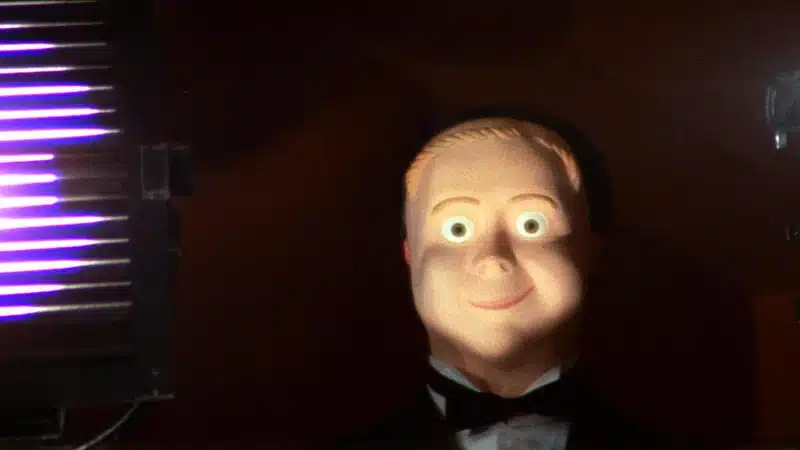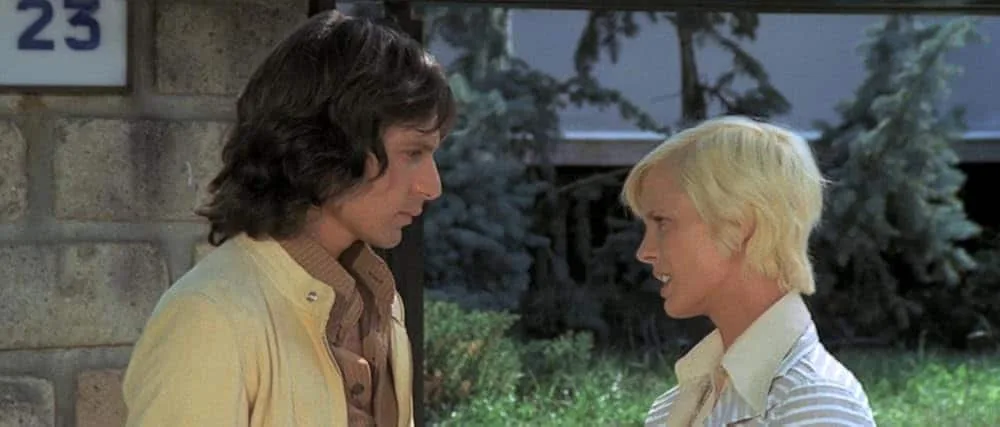
To mark the recent Shameless Films release of Four Flies on Grey Velvet, we’re running a special feature on the film – which contains spoilers. Please watch before you read!
Roberto (Michael Brandon) is a young musician; things should be good, but he’s… nervous. As he has been moving around in the city lately, he has noticed someone who seems to be following him, and one evening – frustrated and paranoid – he gives chase to the man. When he confronts him, a fight takes place and the man is fatally injured as a result. Roberto is therefore implicated in his death; if that wasn’t bad enough, it turns out someone was indeed following him – someone with a camera, who snaps an incriminating reel of photos before making their getaway. Roberto is understandably troubled, and when the photos start to mysteriously appear around his apartment, he feels sure he is being set up for a blackmail attempt, or some kind of life-changing character assassination, the nature of which he can’t quite yet guess. His home is no longer his own, and seems to be quite easily frequented by the person or persons who wish him harm, promising him that further ordeals are coming. Too terrified to tell the police, and deeply reluctant to pour his heart out to his somewhat distant wife, Nina (Mimsy Farmer), Roberto has to use unorthodox methods to try to defend himself, opting for a run of comic-foil private detectives and itinerant friends of his. This has limited success: murder and subterfuge are closing in on Roberto, leaving him essentially alone to face down whatever and whoever is targeting him.
Four Flies on Grey Velvet, the last in Dario Argento’s rather accidental ‘beast trilogy’, is redolent of many of the most desirable traits of Italian genre cinema of the early Seventies. The giallo – named for the lurid yellow-cover pulp crime novels of the mid-20th Century – was rather rapidly developing and reshaping itself as a wealth of ideas, fixations and possibilities emerged in the minds of the genre’s most pre-eminent directors. Dario Argento has described Four Flies as ‘party biographical’, a Freudian nightmare which, like many of Argento’s titles (and certainly his beast trilogy) centres around a male protagonist, rather than a perhaps stereotypically highly-strung female (though that motif certainly comes into play here). It is a film about suggestion as much as it is about meticulously planned murder set pieces; violence is far more often implied than seen. In other respects, it is a dizzying dream world, with dream sequences which function as scene changes, pace shifts and psychological assessments. As much as psychologists are mentioned in the film, psychiatric care happens off-camera, or is relegated to the past – where it has proved rather ineffectual, to say the least. The only help which comes in the film is from people who are outside polite society, themselves abandoned by society’s great institutions. The killer is correct to be so sure that no one is coming: essentially, they aren’t.
Interestingly, the only time the police are really present in the film is to raise the possibility of an experimental procedure which – like most other things in Four Flies – would sit just as happily in an Edgar Allan Poe tale, but for the fact that the daguerrotypes of his day weren’t quite as handy as modern cameras – certainly not for surreptitious snaps. After the murder of Nina’s very accommodating cousin Dalia (Francine Racette), the investigating officer suggests attempting a practice known as (but not named as such in the film) optography, a debunked theory which first arose in the 19th Century, but persisted into the next century too – clearly for long enough to entrench itself in folklore, and to resurface as a fantastical plot point in Four Flies. Optography was the ideas that whatever a person saw in their dying moments would be somehow imprinted on their retinas: find a way to access this image, and you solve the mystery of whatever happened to that person. It’s a kind of charmingly simple, even hopeful idea, nonsense of course, but a bridging point between modern scientific practice and long-held folkloric beliefs about the ingenious behaviour of corpses. It was long maintained that a murder victim’s body would react in the presence of its murderer, a process known as ‘cruentation’; from the other perspective, the ‘hand of glory’ folk tale attributed mystical powers to the severed hands of hanged individuals (see, ahem, my book for more on these). Optography is the perfect addition to Four Flies, then, not only granting it a backstory for that tantalising title, but also adding a layer of myth and perhaps magic to an already heady blend of modernising Italy and forces which seek to infiltrate it, wreaking havoc on its younger generation.
You can easily argue that giallo – on the whole – is inherently reactionary, a horror fantasy of what happens when old forces and values bloodily reassert themselves against those who err. The Late Sixties and early Seventies were particularly fruitful years, a time when Italy itself seemed to grapple quite hard with issues pertaining to its new generation gap. The world of Four Flies seems immediately fraught, a film full of Seventies references from prog rock to space hoppers, but also a world impinged upon by other, older, more knowledgeable others hellbent on exploiting a talented, if nervy young man. From the earliest reels, the presence of the would-be (or could-be) assassin reveals to us an older man, suited and booted and clearly from an earlier era. A party anecdote (!) about the ultra-conservative Saudi justice system has a haunting effect on Roberto, positioning itself as the ultimate terror of powerlessness in the face of deep-rooted institutional power. The reach of the state, and its general disinterest in the individuals it affects, is present elsewhere in the film too: the great vulnerability attached to mental illness and the lifelong impacts of institutionalised care echo through Four Flies, reaching an alarming crescendo during the film’s final big reveal. However, if anything, the message here is that this care has failed. Remote or absent older generations also provide chaos for the young. The sins of the father are visited very literally upon them, even whilst ‘sin’ (and the Church) are conspicuous by their absence. Perhaps in Four Flies (and beyond), the asylum serves a similar purpose. The only ‘God’ here is a drifter, though he does at least come to people’s aid.
Cast adrift in this perplexing, discomfiting modern world, we have Roberto: Four Flies is, above all else, a very lonely film. Even before the film’s denouement, other characters seem to be queuing up to exploit him, and he is a man largely unable, it seems, to defend himself. As the audience, we are positioned in such a way that we’re invited to suspect various people in his life, usually women, but then again we are also made privy to the masked plotter assembling the photographs which incriminate Roberto: it looks for all the world as though we are looking at the film’s villain, but eventually we are disabused of this idea, too. As much as we we get to see Roberto’s trauma dreams, we are not omnipotent spectators in the film and we have to remain on his level, for the most part, as events unfold. We’re as vulnerable as him, and we’re also made to wonder at whoever is picking off other people close to Roberto.
As uncomfortable as it is visually dazzling, Four Flies is an intense viewing experience, hanging onto its secrets until the runtime is very nearly up. That much of this takes place against a rather privileged, easeful background is all the more interesting. The older generation are impoverished; however, Nina is an heiress, Roberto basks in her reflected wealth (well, to a point), and they chide (or ignore) the older, poorer people who work on their behalf, with a big share of the film’s black comedy moments coming at the expense of the working classes; that poor postman deserved more. And yet, for all that money, Nina is psychotically unhappy and Roberto is being targeted by a psychopath. He needs someone with nothing to come and assist him. Money certainly doesn’t buy happiness here, and it takes a rather balletic accident to truly end his ordeal – meaning, again, that chance, not the benevolent reach of old certainties, roll things to a close. Four Flies paints a distinctive, intoxicating version of its place and time, and a delightfully cynical spin on the world in which Dario Argento – then a young man himself – was both making his way and his films.
